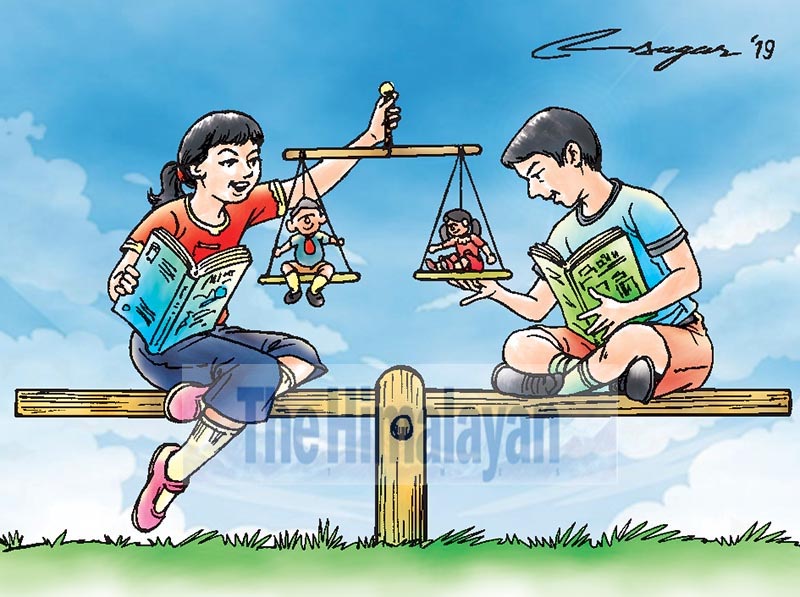Gender stereotypes: Hamper social inclusion
Girls and boys are socialised differently based on gender stereotypes. This creates barriers to education opportunities, capacity building, skill enhancement and self-esteem growth, while hampering gender equality and social inclusion
Sometime last week, there was an issue that went viral on social media: Deputy mayor of Rautahat, who is a female, was claiming that she was being excluded in the decision-making process in her own office by the mayor, who is a male. A similar scenario was revealed by the deputy mayor in Dhanusha. Such instances have occurred outside the local government as well, with women parliamentarians sharing examples of similar behavioural challenges inside the Parliament. In most cases, women are being denied their right to be included and listened to. The question is: Why do such things takes place in society? Are these isolated issues or a defect of the patriarchal system? Does socialisation play a role in embedding this behaviour?
Today, gender is increasingly considered a matter of perception based on stereotypical thinking, one that is created, protected and promoted by society. It can be said that gender stereotypes are deeply rooted and remain salient, which contribute to their persistence in society. For example, we observe female teachers teaching their female students how to make sanitary pads locally, whereas male students and teachers do not get involved in such activities. Society and social institutions may directly or indirectly be involved in promoting gender stereotypes.
The fact of the matter is that academic research on the subject has revealed no evidence to suggest that the minds of men and women are somehow wired differently. Magnetic scans of more than 1,400 human brains could not establish reliable differences in the nature and volume of the brain tissues or connectivity between male and female brains. Similarly, a review of hundreds of studies on math performance, leadership capacity, social behaviours and psychological status reveals more similarities than differences between men and women. One area, however, shows the two behave differently – women are more cautious than men when it comes to sexual behaviour, alcohol and drug use, gambling and driving.
A senior researcher Dr Meena Acharya shares that gender stereotypical behaviour is deeply rooted in all social, political, religious, academic and economic institutions. It is maintained and promoted by the patriarchal society, which creates barriers for social inclusion and development. The Constitution contains many provisions that discriminate against women based on their marital status, including inheritance rights and citizenship rights. There are many formal and informal social institutions in which gender relations are unequal. Even in the same institution with equal qualifications, women face more attitudinal problems than men do.
As such, the stereotype affects occupational roles, too. For instance, certain occupations, such as policing and driving, are dominated by men, whereas nursing seems dominated by women. Studies also show that women across different countries and cultures spend more time in household activities than men do. The stereotype may also be the reason why women are evaluated based on their appearance when commonly assessed for a given role of position.
This was the case for Ann Hopkins, an American business woman who was a consultant and a qualified professional with a high earning capacity. She was deemed unfit for partnership in her firm on the basis of her appearance, behaviour, make-up and dress style, which were considered insufficiently feminine. This case represents a huge systematic pattern in the society as to how women of different races and occupations are evaluated, and is why women are often perceived as less competent.
Stereotypical beliefs, which are developed and maintained through social and educational experiences, shape the mindset of men and women, imbuing in them expectations that conform to the established stereotype. Women are expected to give less priority to their professional career once they become mothers. However, the same cannot be said when men become fathers. These biased expectations create imbalanced career opportunities for women and men. Throughout their careers, women are less likely than men to be selected for promotions, trainings and prestigious positions.
Across the world in many countries, fathers get little to no parental leaves during childbirth and have difficulty retaining custody of their children after divorce. The assumption is that men assign less importance to parenthood than women. No one objects if a married young woman stays at home, but if a man did the same, he is looked down upon by society because of the stereotype that boys should be the providers. He does not get social respect if his wife is the financial supporter while he subordinates at home. As should be clear, the stereotype affects both men and women, and prevents both sexes from achieving true happiness and satisfaction.
Girls and boys are socialised differently based on gender stereotypes. This creates barriers to education opportunities, capacity building, skill enhancement and self-esteem growth. Furthermore, it hampers gender equality and social inclusion in society. Girls have less access to education than boys because they are primarily seen as future wives and mothers. Moreover, gender-based violence is the ultimate means of enforcing unequal social, economic and political relations between them.
Jha is a sociologist






